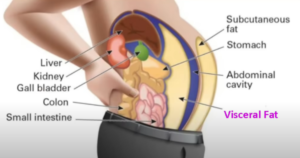How to Get Rid of Visceral Belly Fat: Science-Backed Strategies for a Healthier Body
How to Get Rid of Visceral Belly Fat?

Visceral belly fat is dangerous deep fat surrounding organs like your liver and kidneys. Unlike pinchable subcutaneous fat, it triggers inflammation, raising risks for heart disease and diabetes. Learning how to get rid of visceral belly fat is crucial. Follow these science-backed steps to reduce this toxic fat, improve health, and protect your vital organs long-term
1. Prioritize Quality Sleep (7+ Hours Nightly)
Sleep is foundational for fat loss. Poor sleep disrupts hormones like cortisol and ghrelin, which increase hunger and fat storage. Aim for 7-9 hours of uninterrupted sleep nightly to regulate metabolism and reduce visceral fat accumulation.
Pro Tip: Create a bedtime routine—avoid screens, lower room temperature, and limit caffeine after 2 PM.
2. Hydrate Strategically
Dehydration slows metabolism and promotes fat storage. Calculate your daily water intake by dividing your body weight (in pounds) by two. For example, a 180-pound man should drink 90 ounces of water daily. Hydration flushes toxins, supports digestion, and helps your body burn stored fat efficiently.
Tip: Stay hydrated to “boost metabolism” and “reduce inflammation.”
3. Adopt a Nutrient-Dense, Anti-Inflammatory Diet
A healthy diet is the cornerstone of visceral fat loss. Focus on whole foods like lean proteins, fiber-rich vegetables, healthy fats (avocados, nuts), and complex carbs (quinoa, oats). Avoid processed sugars and refined carbs, which spike insulin and promote fat storage.
4. Incorporate Regular Exercise (Especially Cardio and Strength Training)
Exercise boosts circulation, helping your body access and burn visceral fat. Combine aerobic workouts (walking, cycling) with strength training to build muscle and increase metabolic rate.
5. Track Progress with Waist Circumference

Visceral fat loss isn’t always visible on the scale. Use a tape measure to track your waist circumference weekly. A shrinking waistline (even by half an inch) signals reduced visceral fat and inflammation.
Goal: Aim for a waist circumference below 40 inches (men) or 35 inches (women) to lower disease risk.
6. Manage Stress to Lower Cortisol
Chronic stress elevates cortisol, a hormone linked to visceral fat storage. Practice stress-reduction techniques like meditation, yoga, or deep breathing exercises for 10-15 minutes daily.
Conclusion: Consistency Is Key
Visceral fat isn’t just a cosmetic issue—it’s a health emergency. By prioritizing sleep, hydration, nutrition, exercise, and stress management, you can eliminate this dangerous fat and protect your organs. Start with small, sustainable changes and track your waistline to stay motivated.
Know more about “How to Lose Belly Fat Without Losing Weight” from Here
FAQ
Q: Can I spot-reduce visceral fat?
A:No—fat loss occurs systemically. Focus on overall weight loss through diet and exercise.
Q: How fast can I lose visceral fat?
A:With consistent effort, many see results in 2-3 months. Track waist measurements for progress.
Q:Are there foods that target visceral fat?
A:Yes! Fiber-rich foods (berries, leafy greens), omega-3s (salmon), and green tea help reduce inflammation.



